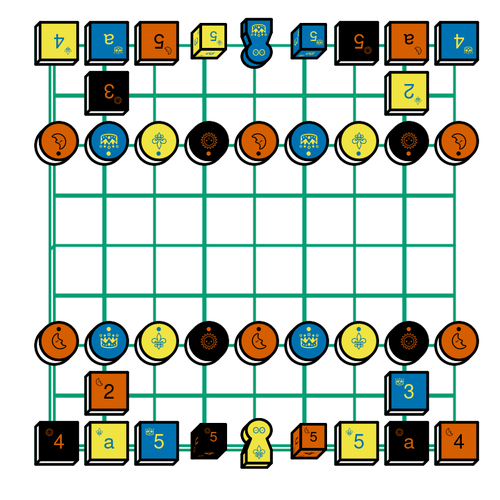StackPack is short for "stacked piecepacks" and refers to the notion of a bigger piecepack and smaller piecepack sized such that the tiles of the smaller piecepack fit within a quarter of the larger tiles. For convenience lets refer to the larger piecepack as a "superpack" and its pieces as "supertiles", "supercoins", "superdice", and "superpawns" and the smaller piecepack as a "subpack" and its pieces as "subtiles", "subcoins", "subdice", and "subpawns". The StackPack has many nice features:
- Assuming one uses the supertiles to make boards one then has 24 supercoins, 24 subcoins, 24, subtiles, 4 superpawns, 4, subpawns, 4 superdice, and 4 subdice which equals a grand total of 82 gaming tokens that can be used on the quarters of the supertiles! This is enough to fill up a 9 by 9 board completely which is definitely enough to play games like Ultimate Tic Tac Toe.
- If your piecepacks have a reversi-friendly design these would be enough flippable tokens (72 in all) to play games like Reversi on an 8 by 8 board.
- One can use the supercoins (as pawns) and subtiles (as the other chess pieces) to play several varieties of Chess and each side's pieces would all be colored flat tokens. Or if you want to get crazy you'll actually have enough pieces to play chess variants like Meta Chess.
- The 24 supercoins, subcoins, and subtiles are three visually distinct game pieces in different sizes which can indicate direction, are somewhat stackable, and come in 4 colors (or even 5 colors if the "neutral side" has a unique color scheme). These can be used instead of Icehouse "stashes" for a large number of Icehouse pieces games.
- One can play AlienCity without any additional pieces.
- Can be used to play various Katarenga games (build the 8-by-8 board indicating color with subtiles, supercoins, and the uncovered special corners of the supertiles).
- One can view the subtiles as a manifestion of the piecepack "stones" accessory suggested in the SensibleExpansions proposal (although the back of the subtiles hides direction whereas the "stones" are supposed to show direction).
- One can use small game tokens from other games on boards made from the subtiles and large game tokens on boards made from the supertiles.
- Can use the subtiles and supercoins to make larger (hex?) boards than one can with just the subtiles.
Sizing
One could size the tiles such that the subtiles exactly fit within a quarter of a supertile. This would be ideal for "tile laying" games but would be hard to use the subtiles as gaming tokens on boards made from the supertiles. The alternative would be to make them such that the subtitles are strictly smaller than a quarter of the supertile which would be ideal for using the subtiles as gaming tokens (but not as pretty for "tile laying" games). Here are some possible sizing suggestions (note the IBG/Mesomorph/BluePanther piecepacks and most PnP piecepack layouts have 2" tiles):
- 2" supertiles and 1" subtiles. Super compact, portable, and likely cheap to make. Lots of really small pieces to move around though which might be an issue especially for those of us with big fingers. Elena "of Valhalla" has already created a "mini piecepack" PnP pdf for making a "mini" piecepack aka "minipack" with 1" tiles.
- 2" subtiles and 4" supertiles. More spacious, less portable, more expensive to make. Ideal for layout type games especially considering 1" by 2" dominoes also fit exactly on these tiles. Harder to use the subtiles as gaming tokens when surrounded by other subtiles (no space around them to pick them up). The sole piecepack currently available on Gamecrafter by Unlimited Media Works seems to have 4" (playing-card-stock) tiles.
- 2" subtiles and 4 1/2" - 5" supertiles. Easier to use subtiles as gaming tokens since room around them to pick them up. 4.5" supertile would lead to 2 1/4" quarters which is the most common tournament chessboard size (5" supertile would lead to 2 1/2" quarters which is the maximum allowed tournament chess board size) so would be ideal for use with tournament/professional chess pieces as game tokens.
- 1 1/2" - 1 3/4" subtiles and 3 1/2" supertiles. Can be manufactured from 2 by 4 lumber, or laser-cut from P1-size materials from laser-cutting services like Ponoko, or even use supertiles made from custom square playing cards from card-making services like TheGamecrafter. Main downside is can no longer use a "standard" 2" tile piecepack as a subpack and lose the synergy with standard 1" by 2" dominoes.
Acknowledgments
I'd like to thank Brian Totter, Chez Campos, RonHaleEvans, Jacob Valdez, James Vipond, Dan Burkey, and Eric Allen Mills for suggestions on naming both the StackPack and related concepts as well as suggestions of games that could be played with a StackPack. -- TrevorLDavis
Way back in 2007 Michael Schoessow suggested the possibilities of combining a half-size "travel" piecepack with a "standard" piecepack as an interesting game system in the MailingList.
One could have three piecepacks sized such that the smallest tile fits within a quarter of the medium tile which in turn fits within a quarter of the largest tile. We could call that game system a Fractal StackPack aka FracStackPack.
Illustrated Examples
Chess
A StackPack would allow for all of your Chess pieces to be suited:

Reversi
A StackPack would have enough pieces to play the full 8x8 version of Reversi:

Shogi
A StackPack has enough pieces to play Shogi (Japanese Chess):

Tak
The game of Tak can also be played with a piecepack stackpack. One can make the board with supertiles. One player will use supercoins as flat stones, subpawns as standing stones, and superpawns as capstones while the other player will use subtiles as flat stones, subdice as standing stones, and superdice as capstones - assuming pawns with circular bases the pieces will be "circles" versus "squares".

![[Home]](https://ludism.org/logo/pplogo_sm.gif)